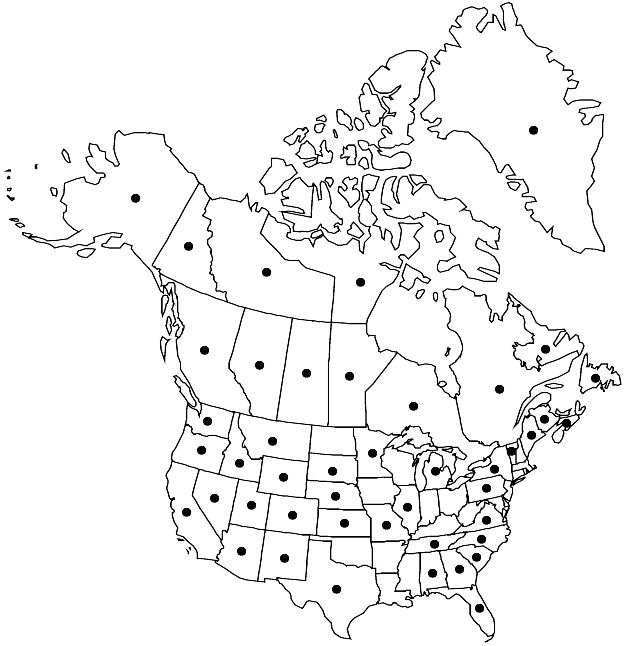Philonotis fontana
Bryol. Univ. 2: 18. 1827.
Plants small to large, in tufts, mats, or sods, light to dark green or yellowish, sometimes reddish or glaucous, reddish brown proximally. Stems 1–16(–20) cm, erect, simple, irregularly branched, or with a subfloral whorl of innovations, tomentose proximally. Leaves with distalmost rarely spiraled around stem, stiffly erect to erect or erect-spreading, less commonly catenulate, erect to erect-spreading when dry, erect to spreading or occasionally secund when moist, lanceolate to broadly ovate-lanceolate or ovate-subulate, 0.6–3 mm; margins revolute, serrulate throughout, teeth paired, appearing 2-fid due to their apposing position from contiguous cells, sometimes margins plane, teeth unpaired; apex gradually to abruptly acute to acuminate, sometimes obtuse; costa short- to long-excurrent (often subpercurrent in obtuse leaves), 320 µm wide at base, distal abaxial surface smooth or weakly prorulose; laminal cells prorulose at proximal ends on abaxial side and at proximal and distal ends on adaxial side; basal cells rectangular to oblong-hexagonal, 15–30 × 5–8 µm; juxtacostal cells at widest part of leaf 24–40 µm; distal cells linear to oblong-linear, 15–40 × 3–5 µm. Specialized asexual reproduction absent. Sexual condition dioicous; perigonia discoid. Seta 2–5(–7) cm, straight. Capsule 1–3.5 mm. Spores ovoid to reniform, 18–30 µm.
Distribution

North America, Mexico, Europe, Asia, Africa, Atlantic Islands (Iceland).
Discussion
Varieties ca. 40 (3 in the flora).
Philonotis fontana has a Holarctic distribution with limited penetration into the montane tropics of both Eastern and Western Hemispheres. The leaves are plane, 2- or pluriplicate, sometimes falcate or falcate-secund. Even given its membership in seepage communities, where morphological plasticity is not uncommon, the extent of variation in this species is excessive. Many variants have been recognized but with little firm evidence to support the majority of them. E. Nyholm (1954–1969) was convinced that only through a series of cultivation, cytological and genetic studies could the immense variability within this polymorphic complex be properly evaluated. W. M. Zales (1973) was able to show by a comparison of cultured and field-derived plants which of the morphological characters were relatively stable and which were subject to environmental influence. His treatment of this complex, with minor deviation, is followed here. The core characters for the species complex are laminal cells prorulose at proximal ends on the abaxial side, juxtacostal cells near the leaf base 24–40 µm, teeth of the leaf margin typically paired and appearing 2-fid, and costa 320 µm wide at the leaf base.
Selected References
None.
Lower Taxa
Key
| 1 | Plants small; leaves stiffly erect, not plicate; capsules 1-2 mm. | Philonotis fontana var. pumila |
| 1 | Plants small to large; leaves erect to spreading or catenulate, sometimes appressed, not, 2-, or pluriplicate; capsules 2-3.5 mm | > 2 |
| 2 | Plants small to large; stems 2-20 cm; leaves imbricate, erect to spreading, not catenulate, sometimes appressed, plane or 2-plicate, distalmost leaves not spiraled. | Philonotis fontana var. fontana |
| 2 | Plants large; stems 5-16 cm; leaves distant, spreading, catenulate, pluriplicate, distalmost leaves spiraled. | Philonotis fontana var. americana |